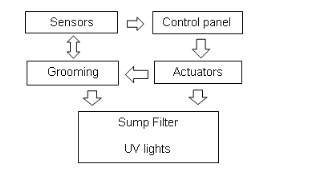
Development of Ornamental Fish-Keeping for Minimal Water Volume
Ardame Dale Pepito, Dexter Lloyd Corgio, John Peter Biares, Paul John P. Infante
College of Engineering Education, University of Mindanao Davao City, Philippines
Publication Information
Journal Title: International Journal of Research and Scientific Innovation (IJRSI)
Author(s):Namonje,Elizabeth;Halwiindi,Hikabasa;Zyambo,Cosmas;Simui,Francis;Muleya,Gistered
Published On: 04/24/2025
Volume: 11
Issue: 9
First Page: 392
Last Page: 400
ISSN: 2321-2705
Cite this Article Pepito, Ardame Dale ;Corgio,Dexter Lloyd ;Biares,John Peter ;Infante,Paul John P.;Development of Ornamental Fish-Keeping for Minimal Water Volume, Volume 11 Issue 9, International Journal of Research and Scientific Innovation (IJRSI),392-400, Published on 04/24/2025, Available at https://rsisinternational.org/journals/ijrsi/articles/development-of-ornamental-fish-keeping-for-minimal-water-volume/
Over the years, more and more people have loved caring for fish as pets, but because some fish lovers are busy, some fish are neglected and tend to die without proper care. Due to these challenges, the proponent of this study aims to build an aquarium with a divider and solar power that can monitor the temperature, pH level in the water, and the water level of tanks and to automate the feeding, flaring, and water recycling processes which has an air pump. The proponent designed and fabricated the automated aquarium using an Arduino Nano microcontroller acting as a controller and relays for the different functions of the tank, such as fish feeders, blinders, and water change. The proponents conducted ten trials to ensure its reliability, precision, and accuracy and used a T-test for the statistical treatment of the study. The device achieved the study’s objectives and performed it optimally. The series of trials found that the device sensed the pH level with a mean of 7.79 for automated and 8.06 for traditional, which has a significant difference with both readings, and for water temperature with a mean of 29.0067 for automated and 28.9867 for traditional, which has a no significant difference with both readings. Also, in automation, the expected water change, feeding, and flaring of the tank have been appropriately carried out as expected in the device. This can help fish hobbyists, keepers, and lovers lessen their efforts to care for their fish pets.
Keywords: Aquarium, Arduino Nano, Relays, Fish Feeder, Blinders
Copyright © 2023 Gyaanarth.com
